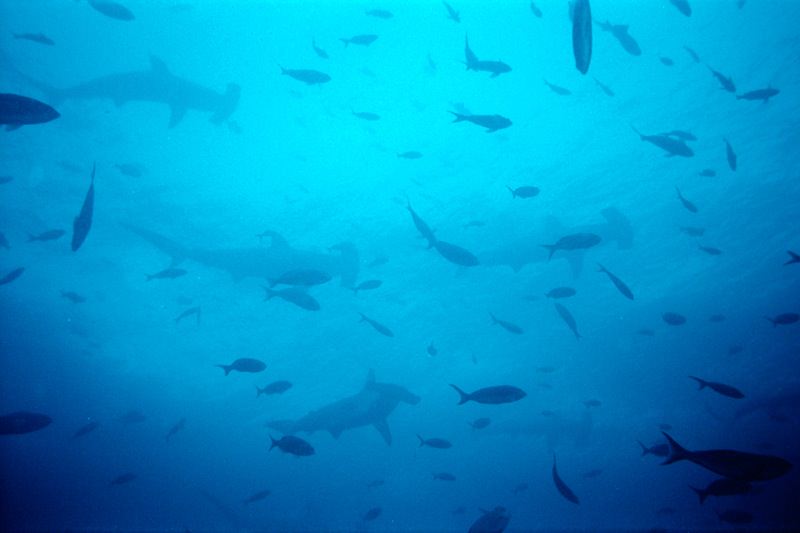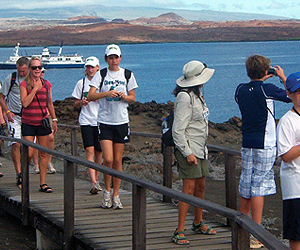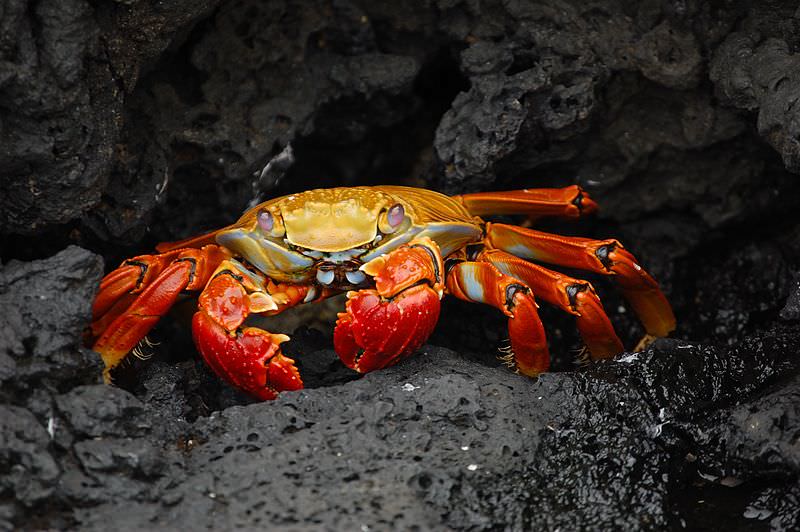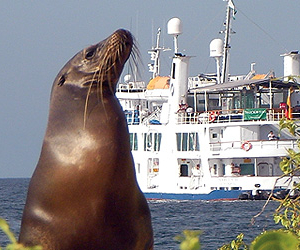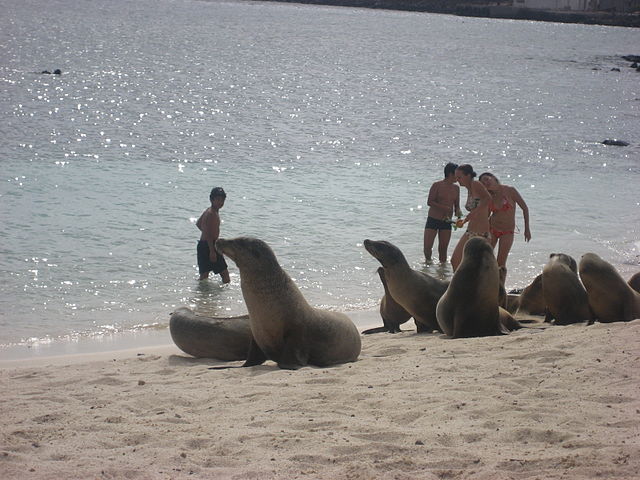
Galapagos Luxury Tours and Cruises
The Galapagos Islands are located 600 from Ecuador, with extraordinary wildlife not found anywhere in the world. It’s a once in a lifetime experience every dedicated traveler or naturalist has to see to believe.
Scuba divers love the Galapagos Islands. There is so much to see underwater that you’ll be terribly disappointed if you don’t bring an underwater camera, so you can show your friends.
Our Virtuoso Travel Advisors will custom design a Galapagos experience that will make a world of difference in the way you vacation. You can benefit from our Virtuoso, South America Travel Advisors experiences. We can guide you to the destinations and attractions that suit you best; get you free upgrades, superior international airfare and added touches that will provide you a Galapagos cruise vacation experience of a lifetime. It helps us help you if you begin with our vacation planner, then we can connect you to the advisor that is most suitable for you.
North Seymour Island – Huge colonies beautiful frigate birds, blue footed boobies and masked boobies: sea lions
Caleta Tortuga Negra (Santa Cruz Island) – mangroves, green turtles, rays and young sharks.
South Plaza Island – Galapagos land iguanas, swallow tailed gulls, red-billed tropic birds, bachelor sea lion colony. Sesuvium plants and Opuntia cacti.
Santa F( Island – Santa F( land iguana, tree-like Opuntia cacti: swimming with sea lions.
Puerto Ayora (Santa Cruz Island) – Charles Darwin Research Station with captive breeding of giant tortoises and land iguanas; wild tortoises and upland vegetation in the highlands, including forests of Scalesia (‘daisy trees’).
Punta Pitt (San Cristobal Island) all three species of booby Blue-footed, red-footed and masked).
Punta Suarez (Espanola Island) – waved albatrosses, blue-footed and masked boobies, swallow-tailed gulls, a blowhole, and colorful marine iguanas.
Floreana Island – flamingos, stilts and other lagoon birds; interesting plant-life such as Leocarpus (cut-leaf daisy), endemic Scalesia; Post Office Bay.
Bartolom ( Island – dramatic volcanic scenery, Tiquilia plants, penguins, snorkeling.
Puerto Egas (Santiago Islands) – fur seals, sea lions, herons, other coastal birds, inter-tidal life.
Genovesa Island – great frigate birds, all three booby species, lava gulls, storm petrels, short-eared owls.
Alcedo Volcano (Isabela Island) – giant tortoises, Galapagos hawks and a caldera view.
Sierra Negra Volcano (Isabela Island) – active fumaroles, caldera view, Galapagos martins.
Elizabeth Bay (Isabela Island) – mangroves, turtles, rays and sharks.
Urbina Bay (Isabela Island – flightless cormorants, pelicans, uplifted corals, large marine iguanas.
Tagus Cove (Isabela Island) – penguins, good views, Darwin’s finches, plants including Galapagos cotton and Macraea (needle-leaf daisy).
Punta Espinosa (Fernandina Island) – flightless cormorants, penguins, rays, inter-tidal life, and spectacular scenery.
In general, the longer you spend in Galapagos, the more you will see. Most itineraries on live-aboard boats are of one week but the larger boats offer 3 and 4-day cruises. Two-week tours are also possible and take you to many of the more distant and less-visited islands, as well as to the central sites. Be aware, however, that you will rarely be the only group at a particular site. You will normally visit two visitors’ sites each day, returning to your boat to eat, sleep and relax. The actual itinerary and sites you visit will either be fixed by your tour operator in advance or decided in Galapagos by your boat captain and guide.
If you decide to do day trips rather than a cruise, you will usually leave early in the morning to visit one or two sites each day, returning to your land-based hotel in one of the towns each evening. Whichever you do, bear in mind that distances between the different islands are quite great (travelling is done largely at night on the live-aboard boats).
The sea can be particularly rough during the garua season (especially August-September) but if you are susceptible to sea-sickness you should take appropriate remedies with you whatever time of year you visit.
Boats
There are a great variety of live-aboard vessels are available, ranging from simple, converted fishing boats to luxurious cruise ships. All rely upon engine power although some also have sails. Which boat you choose depends upon your budget but also upon the style of trip you prefer. The large, comfortable cruise ships offer private bathrooms, bars and sundecks and carry up to 100 passengers. The smaller boats vary greatly from fairly simple 6 passenger vessels to comfortable, modern yachts and launches carrying 12 to 16 passengers. As standards vary, the smaller boats are now classified to indicate the facilities they offer.
The smaller vessels probably provide a more exclusive and adventurous experience. Most crew members are Ecuadorian and invariably work hard to please their passengers. Meals are usually excellent and include plenty of fresh food.
Guides
Each cruise or day trip is accompanied by a guide who is licensed by the GNPS, and no tourist is allowed on land in the park without one. There are several categories of guides, the most knowledgeable of which are naturalist guides who are also likely to have good language skills. A good guide who knows Galapagos well can make a big difference to your trip. The guide is responsible for ensuring that all tourists respect the National Park rules, which stipulate among other things that all visitors must stay on the set trails, and that no animal may be touched.
Time of year
There is always something interesting happening in Galapagos, whatever the time of year, and there is no off-season. From about June to November is the ‘garua’ season when the weather is relatively cool and dry, considering the equatorial position, with sunny or overcast skies and occasional drizzle or garua. August is the coolest month with average daily temperatures ranging from a minimum of 19 to a maximum of 24 degrees Celsius. The sea is cool and can be rather rough. During this period most of the animals which rely upon the sea for their food will be breeding. These include sea and shore birds, marine iguanas, sea lions and fur seals. Between about January and April is the warm season, with higher temperatures and occasional heavy rains. The hottest month is March with an average maximum temperature of 30 degrees. The islands turn green as the arid lowlands bloom, and all the land birds and reptiles start to breed. The sea is warmer and calmer.
Organised tours
Most people book their tour directly from Travelwizard.com as a complete package, which usually includes international flights, hotels and transfers on the mainland, flights out to Galapagos, and the complete cruise in the islands. Insurance, tips and the entrance fee to the Galapagos National Park are usually excluded.
Many specialist operators now exist, often advertising their tours in the weekend press. Our Virtuoso Travel Consultants will also be able to advise you of the boats and itineraries available, or of the options for land-based trips. Most packages will fly you to Quito, the capital of Ecuador, and then on to either Baltra or San Cristobal airport in the Galapagos where you embark immediately onto your boat.
While this may sound like a dream destination to you, it sounds like the Galapagos Islands to me. I have been fortunate enough to have dove the vast majority of the major dive destinations worldwide and when people ask me what destination I think is the best, I don’t even hesitate to give the answer. Only in Galapagos can you see this incredible abundance of large marine animals with such regularity.
Off the remote islands of “Darwin” and “Wolf”, it is common to see thousands of hammerhead sharks and numerous whale sharks. Land excursions are impossible on these islands so this trip is reserved for experienced divers only. Each group is limited to 16 people.
We offer trips to Galapagos all year long.
We offer naturalist trips (non-diving) and dive trips, group trips and individual trips, land based trips (Hotels) and sea based trips (yacht or cruise ship).
We represent numerous yachts, cruise ships and hotels in Galapagos giving you the largest variety of options in a wide range of prices.
We travel to the Galapagos Islands every year so we are very familiar with all aspects of Galapagos vacations.

